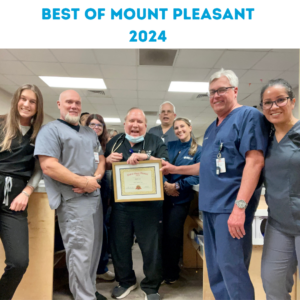We’ve all been to the doctor’s office and got our blood pressure checked, but what do those numbers mean? Hypertension or high blood pressure is the most common diagnosed health condition with a reported 68 million Americans are currently living with high blood pressure. Left untreated, high blood pressure can lead to things like heart attack, stroke, heart failure, kidney disease, vision loss and a host of other problems.
What Does Blood Pressure Measure?
Blood pressure measurements are a necessary function that your body needs to pump the oxygenated blood throughout the body. It is this pumping that creates pressure that pushes blood through blood vessels like arteries, veins, and capillaries. Blood pressure is typically expressed through two numbers. The first number is the systolic pressure with the second number being your diastolic pressure.
What is Systolic and Diastolic?
Systolic blood pressure or the top number indicates how much pressure your blood is exerting when the heart beats. Your Diastolic blood pressure or the bottom number measures the pressure while the heart is resting between beats. Typically, more attention is given to systolic blood pressure. However, either an elevated systolic or an elevated diastolic blood pressure reading may be used to make a diagnosis of high blood pressure.
What is a Normal Blood Pressure Reading?
While there are many factors that may impact a person’s blood pressure, generally a normal reading should reveal a top systolic pressure of a number between 90 to 120 and a bottom diastolic pressure that is between 60 and 80. Anything outside of those ranges could be cause for concern.
What are the stages of Hypertension?
- Stage 1- A systolic pressure ranging from 130 to 139 mm Hg or a diastolic pressure ranging from 80 to 89 mm Hg. Doctors are likely to prescribe lifestyle changes or consider adding a blood pressure medication based on your family history.
- Stage 2- A systolic pressure of 140 mm Hg or higher or a diastolic pressure of 90 mm Hg or higher. Doctors will prescribe a combination of blood pressure medications and lifestyle changes.
- Hypertensive crisis or the “danger zone” is when your blood pressure requires direct medical attention. If your readings suddenly exceed 180/120 consistently, contract your doctor. If you start experiencing chest pain, shortness of breath, back pain, numbness and weakness or vision changes call 911 immediately.
Our urgent care centers are open every day of the week 8:00 am to 8:00 pm- No appointment necessary! From 8am to 7pm we offer Rapid Antigen and send-out PCR COVID-19 testing, as well as COVID-19 antibody testing. To be seen by a provider, simply walk in, or save your spot online for visits by clicking here. For information on E-registering to save time click here. We look forward to helping you Get Better. Faster!
https://www.heart.org/en/health-topics/high-blood-pressure/understanding-blood-pressure-readings

